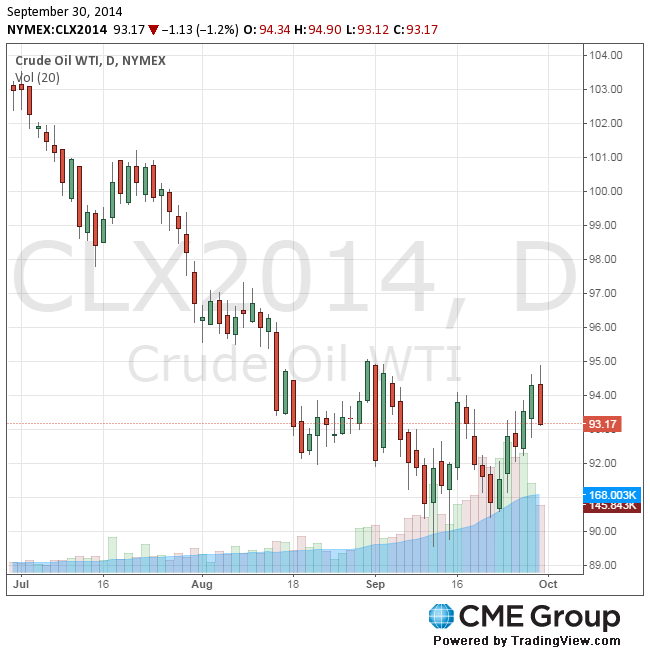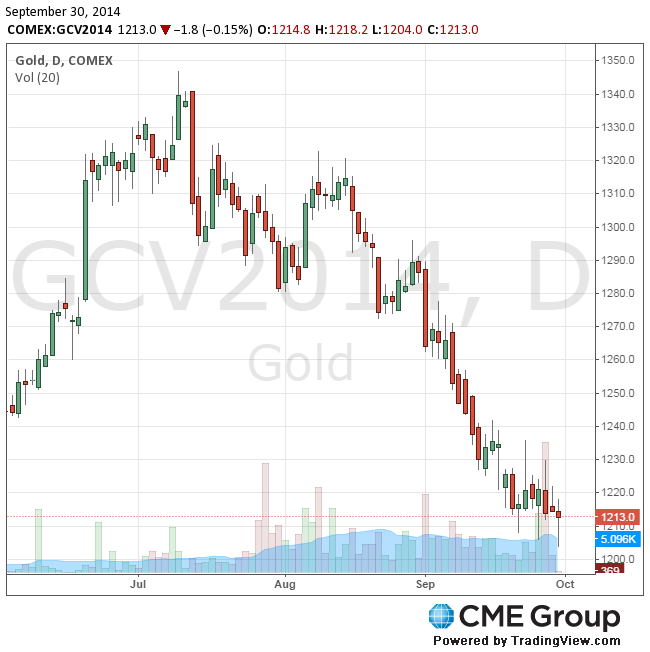Notícias do Mercado
-
23:38
Commodities. Daily history for Sep 30'2014:
(raw materials / closing price /% change)
Light Crude 91.42 +0.29%
Gold1,209.80 -0.15%
-
16:42
Oil set for biggest quarterly drop since 2012
West Texas Intermediate and Brent crudes headed for the biggest quarterly decline in more than two years as ample supply shielded the market from the risk of disruption from conflict in the Middle East.
Futures slid as much as 1.2 percent in New York today and 0.5 percent in London. U.S. crude stockpiles probably expanded by 1.5 million barrels last week, a Bloomberg News survey showed before an Energy Information Administration report tomorrow. Prices also dropped as a dollar index strengthened to a four-year high, reducing the investment appeal of commodities.
"We are going to continue to see lower prices as we go forward," said Tariq Zahir, a New York-based commodity fund manager at Tyche Capital Advisors. "Fundamentally we are just very well supplied. The dollar continues to get stronger and it's adding pressure on oil."
WTI for November delivery fell 95 cents to $93.62 a barrel at 10:13 a.m. on the New York Mercantile Exchange. Prices have lost 11 percent this quarter, the most since June 2012. The volume of all futures was 64 percent above the 100-day average.
Brent for November settlement slid 39 cents to $96.81 a barrel on the London-based ICE Futures Europe exchange. Volume was 12 percent above the 100-day average. Prices have decreased 14 percent this quarter. WTI was at a discount of $3.18 to Brent on ICE, compared with $2.63 yesterday, which was the narrowest close since August 2013.
Both grades are also set for the third straight month of losses as supply gains offset the U.S.-led military campaign against Islamic State.

-
16:20
Gold updated a nine-month low
Gold prices decline as rising expectations of higher interest rates in the United States and much got stronger dollar continue to put pressure on precious metals.
Gold futures declined by 9.2% in the three months ended September 30, amid speculation that the strengthening of the economic recovery in the United States will push the Federal Reserve to an earlier and more rapid increase in rates than previously expected.
For storage of gold funds are needed, and it is inferior to the competition with earning assets at higher interest rates.
Meanwhile, the USD index rose nearly 7.5% in the quarter, noting the largest jump since the global financial crisis of 2008.
A strong dollar usually puts pressure on gold, because it reduces the metal's appeal as an alternative asset and increases the cost of dollar-denominated commodities for holders of other currencies.
Today we have published data on the housing market the United States, which have provided some support to the dollar. Housing prices in 20 American cities have grown by the end of July, but showed the slowest pace in nearly two years, as tight credit conditions and weak wage growth have put pressure on demand.
July house price index from the S & P / Case-Shiller increased by 6.7 per cent (the smallest increase since November 2012), after rising 8.1 percent in the previous month. Experts expect that this figure will grow more significantly - by 7.5 percent.
The cost of the October gold futures on the COMEX today dropped to 1204.00 dollars per ounce.

-